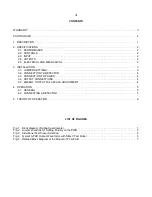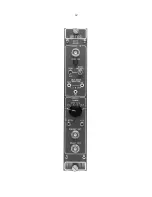
2
2. SPECIFICATIONS
2.1. PERFORMANCE
ENERGY RANGE Six positions on the front-panel
switch for selecting the desired energy range (see
DETECTOR AND ELECTRONIC NOISE <25 keV
PERFORMANCE).
FWHM when used with ORTEC R Series, 300 mm
2
and 450 mm charged-particle detectors, and <35 keV
E BIAS 15-turn potentiometer on the front panel
2
for 600 mm and 900 mm R Series charged-particle
permits screwdriver adjustment of the energy output
2
2
detectors when connection of the Model A-576 to the
bias point to be varied by ±10% for ease of setup with
detector is made with <2 ft of RG-62A/U cable.
the data acquisition system.
System noise is dependent on detector capacitance
plus cable capacitance and leakage current. Electronic
E 15-turn potentiometer on the front panel permits
noise is typically 5 keV with a slope of 25 eV/pF silicon
screwdriver adjustment of the maximum energy output
equivalent (based on
= 3.6 eV and t = 0.5 µs
range to be varied from 7.75 to 10.25 V for ease of
(internal amplifier).
setup with the data acquisition system.
PULSE SHAPING Internal 0.5-µs active filter semi-
TEST PULSER PWB jumper (J2) allows selection of
Gaussian pulse shaping amplifier provides a pulse that
internal pulser energies of 5 MeV, 6 MeV, or 7 MeV.
is stretched prior to being output through the Bias
Amplifier to give a 4-µs-wide positive output pulse.
INPUT/BIAS POLARITY PWB jumpers allow
ENERGY RANGES 3 TO 8 MeV, 4 to 7 MeV, 3 to 5
polarity. Negative for ORTEC Surface Barrier or Ion-
MeV, 4 to 6 MeV, 5 to 7 MeV, 6 to 8 MeV.
Implanted Ruggedized detectors, or positive for
conventional detectors. (Shipped in Negative position.)
CALIBRATED TEST PULSER Equivalent Energy
5 MeV, 6 MeV, or 7 MeV. (Shipped at 5 MeV). Rate is
100 Hz.
2.3. INPUT
DETECTOR BIAS VOLTAGE Continuously variable
PREAMP IN Front- and rear-panel BNCs accept an
over range of 0 to 100 V. Polarity selectable with
input signal from semiconductor charged-particle
printed wiring board (PWB) jumper shipped in negative
detectors. Either RG-62A/U or RG-71A/U cable is
position (appropriate for ORTEC R Series detectors).
recommended to minimize excess capacitance and
Shipped set to 100 V.
hence noise.
2.2. CONTROLS
2.4. OUTPUTS
TEST/BIAS/OFF Front-panel, three-position toggle
ENERGY Front- and rear-panel BNC connectors
switch controls both the detector bias voltage and the
provides a positive stretched pulse from 7.75 to
test pulser. Front-panel LED is illuminated when the
10.25 V maximum, depending on the setting of the
E
bias voltage is on.
gain control corresponding to an energy range
DET BIAS ADJ Front-panel potentiometer for
4 µs; Z = 100
6
; dc-coupled.
controlling the bias voltage applied to the detector.
Continuously variable from 0 to ±100 V.
selection of either positive or negative detector voltage
selected on the front-panel switch. Pulse width =
0
Содержание ORTEC A-576 A-PAD
Страница 4: ...iv ...





























